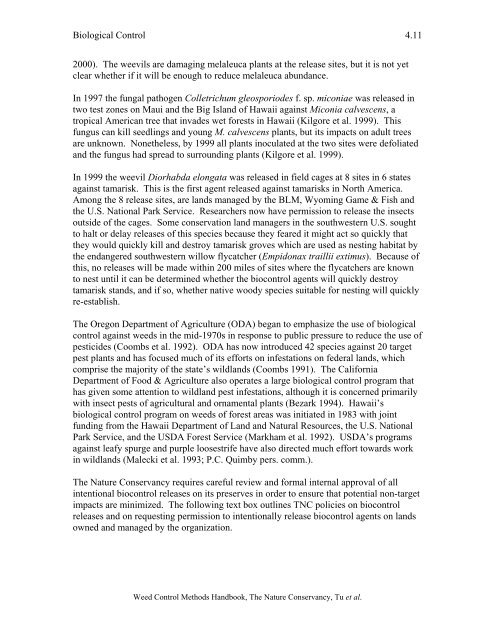Weed Control Methods Handbook: Tools ... - Invasive.org
Weed Control Methods Handbook: Tools ... - Invasive.org
Weed Control Methods Handbook: Tools ... - Invasive.org
You also want an ePaper? Increase the reach of your titles
YUMPU automatically turns print PDFs into web optimized ePapers that Google loves.
Biological <strong>Control</strong> 4.11<br />
2000). The weevils are damaging melaleuca plants at the release sites, but it is not yet<br />
clear whether if it will be enough to reduce melaleuca abundance.<br />
In 1997 the fungal pathogen Colletrichum gleosporiodes f. sp. miconiae was released in<br />
two test zones on Maui and the Big Island of Hawaii against Miconia calvescens, a<br />
tropical American tree that invades wet forests in Hawaii (Kilgore et al. 1999). This<br />
fungus can kill seedlings and young M. calvescens plants, but its impacts on adult trees<br />
are unknown. Nonetheless, by 1999 all plants inoculated at the two sites were defoliated<br />
and the fungus had spread to surrounding plants (Kilgore et al. 1999).<br />
In 1999 the weevil Diorhabda elongata was released in field cages at 8 sites in 6 states<br />
against tamarisk. This is the first agent released against tamarisks in North America.<br />
Among the 8 release sites, are lands managed by the BLM, Wyoming Game & Fish and<br />
the U.S. National Park Service. Researchers now have permission to release the insects<br />
outside of the cages. Some conservation land managers in the southwestern U.S. sought<br />
to halt or delay releases of this species because they feared it might act so quickly that<br />
they would quickly kill and destroy tamarisk groves which are used as nesting habitat by<br />
the endangered southwestern willow flycatcher (Empidonax traillii extimus). Because of<br />
this, no releases will be made within 200 miles of sites where the flycatchers are known<br />
to nest until it can be determined whether the biocontrol agents will quickly destroy<br />
tamarisk stands, and if so, whether native woody species suitable for nesting will quickly<br />
re-establish.<br />
The Oregon Department of Agriculture (ODA) began to emphasize the use of biological<br />
control against weeds in the mid-1970s in response to public pressure to reduce the use of<br />
pesticides (Coombs et al. 1992). ODA has now introduced 42 species against 20 target<br />
pest plants and has focused much of its efforts on infestations on federal lands, which<br />
comprise the majority of the state’s wildlands (Coombs 1991). The California<br />
Department of Food & Agriculture also operates a large biological control program that<br />
has given some attention to wildland pest infestations, although it is concerned primarily<br />
with insect pests of agricultural and ornamental plants (Bezark 1994). Hawaii’s<br />
biological control program on weeds of forest areas was initiated in 1983 with joint<br />
funding from the Hawaii Department of Land and Natural Resources, the U.S. National<br />
Park Service, and the USDA Forest Service (Markham et al. 1992). USDA’s programs<br />
against leafy spurge and purple loosestrife have also directed much effort towards work<br />
in wildlands (Malecki et al. 1993; P.C. Quimby pers. comm.).<br />
The Nature Conservancy requires careful review and formal internal approval of all<br />
intentional biocontrol releases on its preserves in order to ensure that potential non-target<br />
impacts are minimized. The following text box outlines TNC policies on biocontrol<br />
releases and on requesting permission to intentionally release biocontrol agents on lands<br />
owned and managed by the <strong>org</strong>anization.<br />
<strong>Weed</strong> <strong>Control</strong> <strong>Methods</strong> <strong>Handbook</strong>, The Nature Conservancy, Tu et al.
















